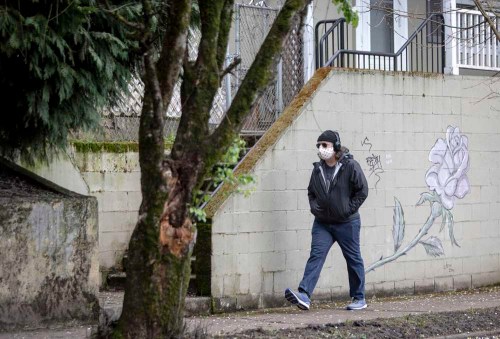Oregonians have died at rate well above average since mid-March, but tie to COVID-19 unclear, state data show
Published 11:00 am Wednesday, April 29, 2020

- A person walks along the street in Northeast Portland wearing a mask during the coronavirus pandemic on April 2, 2020.
SALEM — More Oregonians died the past month than is typical in mid-March and early April, according to data released by state health officials, but fewer than half the excess deaths were officially connected to coronavirus.
In all, 245 more Oregonians died during the five weeks between March 16 and April 19 than during those same five weeks in 2017, 2018 and 2019, on average. During those five weeks, 78 Oregonians died from COVID-19, according to the state health authority’s official count.
Trending
It is unclear if other fallout from the pandemic, including a fear of seeking health care, played a role in the other 167 deaths, and officials said the data are preliminary. What is clear: Nearly all the above-average deaths occurred at home, among Oregonians both receiving and not receiving hospice care.
In the first full week of April, 47% of deaths in Oregon occurred at home, 7 percentage points more than the three-year historical average. As deaths at home rose, the share of residents dying in hospitals declined.
The data leave unanswered questions about what is killing so many Oregonians. They come as a Yale University School of Public Health analysis of federal death figures for The Washington Post determined there were at least 15,400 deaths above historic averages during the early days of the pandemic nationwide.
But the data are yet another indication that Oregonians’ effort to stay home is paying dividends. While some states have seen dramatic upticks in deaths and devastating levels of COVID-19 fatalities, Oregon has one of the nation’s lowest per capita COVID-19 death rates, according to Dr. David Bangsberg, dean of the OHSU-PSU School of Public Health. And excess deaths in the state, while sizable, are not eye-popping in their scope.
Between March 30 and April 5, an estimated 803 Oregonians died, up from the three-year total of 736 deaths during that week. Twenty of those 67 above-average deaths were officially connected to COVID-19. The following week, overall deaths declined to 748, mirroring the annual declines typical during the end of flu season, but the overall death figures were still higher than the average of 705.
State health officials have taken notice.
Trending
“The percentages of deaths that are occurring at home are higher,” said Jennifer Woodward, the section manager of the Center for Health Statistics within the state health authority. But, she said, her agency hasn’t looked into how those people died.
Dr. Jennifer Vines, the lead public health officer for the three-county Portland area, said health officials are keeping close tabs on the situation, but they don’t expect the increase in people dying at home were among people infected with COVID-19.
“Hospitals know to test someone who arrives and dies either without a clear diagnosis or with reason to believe they had a viral illness that preceded their death,” she said in an email. “The same advice goes for our county medical examiners who have test kits to use under the same circumstances for the deaths they investigate.”
Vines said that while no system is foolproof, she has “no reason to think we are missing large numbers of deaths due to COVID-19.”
Those outside the state and county health circles aren’t as certain. The share of above average-deaths not attributed to the virus was at its highest in March, when testing was less available and the symptoms of the novel disease less well-known, The Oregonian/OregonLive analysis shows.
Bangsberg, the public health dean, credited state officials and residents for helping keep the epidemic here under control.
But many fewer patients are being treated in hospitals, with nearly all hospitals running significantly below typical capacity, including a 40% decline at OHSU, he noted. Bangsberg said that knowledge, combined with the overall lack of testing, point to more known cases than expected.
“There probably is a real bump in excess mortality, related to COVID-19,” he said.
It’s also possible the deaths could be “a random variation,” Bangsberg said.
This article was originally published by the The Oregonian/OregonLive, one of more than a dozen news organizations throughout the state sharing their coverage of the novel coronavirus outbreak to help inform Oregonians about this evolving heath issue.









